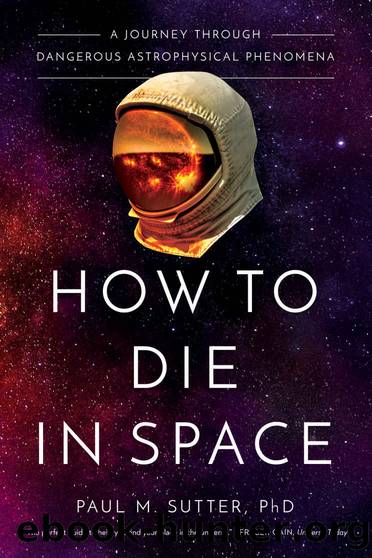How to Die in Space: A Journey Through Dangerous Astrophysical Phenomena by Paul Sutter

Author:Paul Sutter [Sutter, Paul]
Language: eng
Format: azw3
Publisher: Pegasus Books
Published: 2020-06-01T16:00:00+00:00
* * *
There are other ways to make a scene. Sometimes, a do-nothing middle-of-the-road star gets a chance to see its name in lights.
The story of death and destruction I just told—called core collapse if you’re a normal human being and Type II if you’re an astronomy nerd—was based on the life of a giant star in isolation; this is simply how they end their lives. But stars are hardly ever alone. The sun has a few planets to call its friends, and many stars—about half—come in pairs, or triplets, or even more.
And interesting things can happen in your life if you have a friend.
We met in the last chapter a common sight in every galaxy: a pair of stars, one already in its post-death stage as a white dwarf, and the companion in its near-death stage as a red giant. With the right setup, some of the atmosphere from that giant can be siphoned off onto the surface of the white dwarf, creating a thick blanketing atmosphere of hydrogen.
When things go critical in that layer of hydrogen, it flashes into a nova, a flare of light that dazzles and awes, burning through that hydrogen in a fantastic thermonuclear event.
But it can get worse. Much, much worse. Like when that layer of gas from the red giant companion cracks the white dwarf like a shell of an egg.
Sometimes the hydrogen can pile up without ever having the exact right conditions to fuse itself. It just gets thicker. And heavier. Inside that layer, the white dwarf starts to react. The pressures and temperatures climb. As the white dwarf nears the limit of stability, as gas piles up on the outer layers, the core of the white dwarf starts to convect, just like the plasma inside the sun and just like a boiling pot of soup. A soup of oxygen and carbon, not exactly tasty, but viscerally intense.
This isn’t a stable situation: a planet-sized nuclear bomb, weighing as much as the sun, just waiting for a fuse to set it off.
Somewhere, at some point on the white dwarf, the temperature and pressure from the thick hydrogen atmosphere get high enough to ignite the fusion of carbon. That little spark, that tiny fire of fusion, releases a little bit of energy. The released energy is enough to trigger carbon fusion in the area around it, which in turn spreads the fusion reaction even further.
Completely without warning, a crisis point is reached. A spark has been ignited inside the white dwarf, a brief flicker of fusion.
And it spreads throughout the star, like the lick of a flame on a puddle of gasoline, igniting fusion wherever it goes. In a normal everyday star, this process would be confined to the core, keeping the temperature and pressure regulated so that it didn’t get out of control. In those cores, the increased heat from the fusion would puff out the star, easing the pressure and cooling off the rate of reactions. But a white dwarf isn’t a
Download
This site does not store any files on its server. We only index and link to content provided by other sites. Please contact the content providers to delete copyright contents if any and email us, we'll remove relevant links or contents immediately.
| Aeronautics & Astronautics | Astronomy |
| Astrophysics & Space Science | Comets, Meteors & Asteroids |
| Cosmology | Mars |
| Solar System | Star-Gazing |
| Telescopes | UFOs |
Tools of Titans by Timothy Ferriss(8304)
Turbulence by E. J. Noyes(7978)
Secrets of Antigravity Propulsion: Tesla, UFOs, and Classified Aerospace Technology by Ph.D. Paul A. Laviolette(5333)
Astrophysics for People in a Hurry by Neil DeGrasse Tyson(5151)
Room 212 by Kate Stewart(5071)
Design of Trajectory Optimization Approach for Space Maneuver Vehicle Skip Entry Problems by Runqi Chai & Al Savvaris & Antonios Tsourdos & Senchun Chai(5037)
Pale Blue Dot by Carl Sagan(4954)
The David Icke Guide to the Global Conspiracy (and how to end it) by David Icke(4657)
A Journey Through Divination and Astronomy by Publishing Pottermore(4363)
Goodbye Paradise(3761)
Apollo 8 by Jeffrey Kluger(3668)
COSMOS by Carl Sagan(3589)
The Five People You Meet in Heaven by Mitch Albom(3520)
Losing the Nobel Prize by Brian Keating(3518)
How to Read Water: Clues and Patterns from Puddles to the Sea (Natural Navigation) by Tristan Gooley(3433)
Brief Answers to the Big Questions by Stephen Hawking(3393)
How to Read Nature by Tristan Gooley(3292)
The Order of Time by Carlo Rovelli(3162)
A Brief History of Time by Stephen Hawking(2992)
